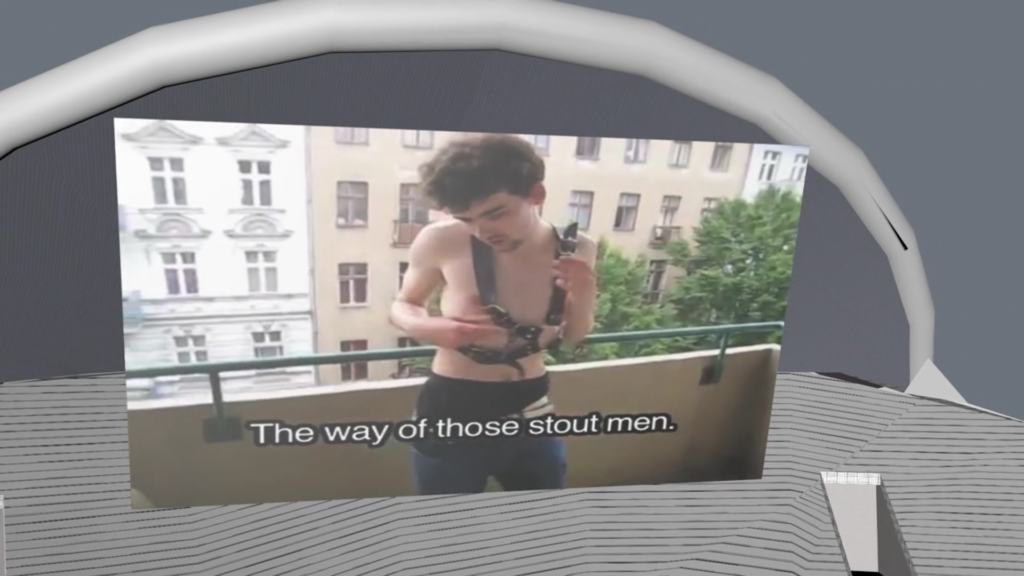1. State of Cloud
What role can singing play when a nation is faced with annihilation by its neighbours?
What role can a ponytail play when a country is under cyber attack by its neighbours?
What role can a user play in a state of cloud?
Self-articulation of a collective subjectivity through singing becomes an expression of freedom. Self-articulation through a ponytail on earth and in the cloud becomes a governing norm.The long blond hair bound into a ponytail with an ID-card reader implies the idea of a fixed identity conflated with identification. It indicates cybernetic governance over subjects whose subjectivity is irrelevant. Hair is people. Hair is a collective subjectivity. A soldier’s head is shaved to incorporate him as a cog in the war machine.

Fig .2. State of Cloud (2014), still
1.1 Cloud Identity is a State of Affect
In a state of cloud, a user’s cognitive borders dissolve the same way a country’s physical borders do, making them non-contiguous to its neighbouring countries. The state of cloud (‘pilvesolek’ to be inside a cloud, to be high, euphoric, under the influence of some kind of drug) transfigures a person’s cognitive borders that hold together their identity. An identity is a fixed state of affect which can be dictated.
In the video State of Cloud (2014), a patriotic song from the Singing Revolution is used to dictate a specific notion of “Estonianness”. However, since the person interpreting this song in the video (Fig. 2) is already in a state of affect or in a “state of cloud”, he is unwilling to have his identity fixed in the way that the song orders. He is ecstatic and therefore cannot be fixed or clearly defined. Instead, he remains in a state of constant fluctuation and transposition. He performs a new national imaginary which displeases large numbers of Estonians, who find it hard to give way to this new free-floating rootless version of an Estonian in the midst of constant re-synthesization.
While in State of Cloud (2014) a patriotic-cum-nationalist song is used to lure a British citizen to become an Estonian, in the video piece Barbed State (2016) by SKATKA, an Australian-accented pilot tries to convince people to work in Estonia. One could wonder if a speaking human-shaped airport video ad is already in a “state of cloud”? Could a “state of cloud” polity be the foundation for an updated Estonian identity? The American media theorist Benjamin Bratton describes this cloud polity as “being developed and formed without geographic and historical legacy and for whom the cloud’s own geographic situation is the first basis of emergent sovereign imaginaries.” (1)

Fig. 3. State of Cloud (2014), still
1.2 The Order of Scrunchy
Can culture hold people together the way a scrunchy holds together the long and curly beautiful blond hair of someone who works for Estonia’s Computer Emergency Response Team (CERT)?
In Generation X, Douglas Coupland described the notion of the “bleeding ponytail” as “a Baby Boomer who pines for hippie or pre-sellout days and displays these feelings by wearing a ponytail.”(2) The Silicon Valley revolutionary of the counterculture era has turned into a techno-capitalist visionary and a manifestation of The Californian Ideology. The hair that once flew freely in the winds of West Coast utopias is now worn with pride in a ponytail that is ordered by a scrunchy. The scrunchy holding together the sysadmin’s hair is like a cybernetic feedback loop that orders a system, as culture shapes a collective image of national subjecthood. This transitioning of identity bears similarities to the story of Estonia since its restoration of independence in 1991. This is the story of a country that regained its independence and established democracy thanks to the Singing Revolution and became a technologically advanced society of start-ups and e-governance, where the corporate vision of Silicon Valley is often taken at face value.
1.3 Identification as Identity: 10000 e-residents and 10000 f-residents
Today, besides Skype and 10000 e-residents, Estonia is also known for the highest rate of drug-related deaths in Europe, mostly because of Fentanyl, an opiate up to 100 times more potent than heroin. One could say that Fentanyl also operates as a quasi-platform for around 10000 residents to enter into a state of cloud every day. For these users, Fentanyl becomes the application for becoming part of a collective subjectivity that is formed in the cloud.
In a way, the Cloud Polis model of Estonia is similar to that of Facebook, as it gives e-Estonians a platform for a fixed identity and self-articulation. Estonia claims to provide strong digital identities to its residents.(3) These digital identities operate as identification for citizens to enjoy state services online. The rhetoric of e-governance, the e-residency programme and Estonia as a digitally advanced society have become parts of the country’s national branding campaign, which in a way has also started to constitute national selfhood.
What is happening is a strange conflation of identity with identification. Cloud computation and using state services are suddenly forms of self-articulation.(4) Therefore, Estonian identity is supposed to be nothing more than a user identity, regardless of whether the platform is X-Road or Fentanyl. The difference between e- and f-residents lies in how they are represented by the state, where the latter are excluded from national branding narratives both inside and outside of the country. The representation of f-residents is securely included in Google Cloud’s Youtube platform as moving images, while their terrestrial existence remains in a precarious state.
1.4 Digital Discontinuities
The Digital Continuity programme announced by Estonia in February 2014, which promised to keep the computational cloud infrastructure continuously working even in case of a physical attack, hints at modes of exclusion integrated into Estonia’s Cloud Polis model. Should all physical infrastructure of the country be destroyed, including the residents, the Cloud infrastructure could potentially continue working via Cloud embassies. Estonia’s identification platform, online services and payment platforms would continue to route digital flows of e-migrants and money.
This illustrates further how the idea of e-residency has been hijacked by corporate interests hiding under the state’s name and not acting in the service of the further development of democracy. This world is mostly about economic efficiency, which assumes that democracy is a ready-made object and all citizens are continuously equally represented in the process of making a country. As Aro Velmet has noted, while the earlier vision of e-democracy could be called utopian, with its hope of radical inclusion, the newer utopia becomes radical in its hope of making people, under the control of government, more like clients and the state itself a service provider. He continues by looking at this change of perspective, where e-citizens have turned into e-consumers:
“This e-state vision that Bloomberg and Foreign Affairs write about and that is prevalent in Estonian discussion does not have much in common with the discursive online democracy envisioned by former President Lennart Meri. ‘Progress’ in Bloomberg’s view emphasizes the public sector’s efficiency, fast bureaucracy favouring business practices and good digital infrastructure. It is not the active citizens who would live in this new ‘digital nirvana’ and use smartphones to participate in creating the budget for their local government, give feedback to new legislation or elect a parliament during a lunch break. It would instead be either consumers, who communicate with the state when they need to pay taxes or receive digital prescriptions, or entrepreneurs, for whom the digital world means saving time in procedures and new business opportunities.” (5)
In this case, if the idea of a borderless e-residency becomes reduced to a neoliberal service package through such language, it would in itself reinforce the current relationship between state and citizens as a finalized product. When a country is competing for relevance with other institutions, branding becomes key. The branding of states has become one of the examples of how states are adopting the language of corporate entities and how the simple distinction between market and state becomes more complicated. Through building a strong image of a place, or simply by branding the place, the attraction and the legitimacy of that place rises.
Joseph Nye, who came up with the term “soft power” writes that, “power today is less tangible and less coercive among the advanced democracies than it was in the past. At the same time, much of the world does not consist of advanced democracies and that limits the global transformation of power.”(6) Soft power has become a widely used term related to the ability to attract other subjects at the level of the state. Thus, soft power as opposed to hard power can be viewed as a tool that functions within the larger framework of the state exercising power while using the corporate language of trademarks, design and branding.
2. A Barbed State
2.1 #digitallywelcome #physicallynotwelcome
In May 2015, Estonia launched its e-residency programme the same week the EU announced refugee intake quotas for its members.
Today Estonians have unprecedented freedom to cross borders. In addition, there is infrastructure that allows local and foreign users to enjoy the benefits of digital Estonia across borders. Nevertheless, the cognitive borders of being an Estonian are still determined by symbolic pollution hovering in the psychosphere. Therefore, it seems that, while in the digital space cocktail glasses are clinking and everybody is more than welcome, the demarcation of borders in the physical space has yet to be eliminated.
By exploring the audio-visual legacies that may have potentially inscribed biases and enforced othering, SKATKA looked into the grey areas of the imagined national identity. An excellent example for the articulation of making a common imaginary is the legendary Estonian children’s movie Bumpy (1980). The film represents the nation-state’s border making, marginalisation, internal power relations, migration and assimilation. It is derived from the Hansel and Gretel archetypal tale of children getting lost in the woods and being kidnapped by a witch, who forces them to perform manual labour in a gross and uncanny environment. (fig. 5)
One of the biggest Cloud-based service providers, Amazon’s Mechanical Turk platform, allows clients to outsource tasks to remote workers via the internet; these workers are paid on commission but don’t have their social security fees covered by their temporary employer. Although the “Work in Estonia” campaign does not necessarily aim to attract an outsourced workforce, some of the people who actually followed the campaign to Estonia met similar conditions as Mechanical Turks on digital platforms. Even though the campaign paints a picture of seamless integration, becoming a physical resident involves a lot of bureaucracy and sometimes even harassment by the state apparatuses.(7)
Mechanical Turks are a good example of human users (of the cloud) who are often mistaken for non-human users of the cloud. Most people consider the tasks they perform to be automated by such non-human actors as bots and algorithms. For SKATKA, this is problematic since it corresponds to the attitude towards our potential digital residents should they ever enter the physical space of Estonia, where non-Estonian users are still often considered non-human by locals. This might compromise the process of assimilating foreign workers into the country.

Fig. 4. Barbed State (2016), still
2.2 All Work and No Play
The protagonists of of the movie Bumpy, are a brother and sister named Iti and Kusti, who were forced into harsh labour by a witch. They are kept separate and made to work until they are completely exhausted, in order to keep them from mobilizing and planning an escape. The labour conditions of Mechanical Turks are similar, since the workers are separated and never meet in real life. This protects the employer from the workers ever unionising. It is an updated version of the McDonald’s ”employee of the month” model that integrates competition between workers and produces internal othering that operates as a form of control.
The witch asserts her power over Iti and Kusti by utilizing several biological others: she has an army of supernatural spies, such as cats and birds, that constantly monitor her house and the forest, and operate as her remote vision. The forest is her platform, where she has omnipresence and Iti and Kusti have signed away their end-user agreements by entering the forest. The whole operation of the witch is aligned with the forms of control in the age of platform capitalism, where control by communication is key.

Fig. 5. Barbed State (2016), still
3. Possible Futures for Collective Creation
Could Iti and Kusti represent potential foreign workers and their experience on Estonian soil, while the members of SKATKA themselves represent the bogeys living in the forest? In a sense, they embody the experience of a transnational subjecthood and the naive provincial desire to become cosmopolitan citizens of the world.(fig. 6)
By conflating identification with identity, Estonia might reach the gloomiest and most dystopian conclusion of this digital fairytale of automated participation faster than any other country. It will move us further away from any form of collective self-mastery, as we are already losing ourselves to the global Cloud megastructures, such as Google, Amazon, Facebook and Apple, and the personalized commercial echo chambers they create for us. We need to find a mutual voice to sing with on a global scale, not just within the nation-state, as our identities become increasingly segregated digitally and physically into users who lack a collective perspective, besides the next (pre-destined) personalized commercial act facilitated by the state as cloud platform. The conditions of citizens grow more similar to those of Mechanical Turks, where a dialogue between the state and its citizens ceases to exist and political decisions are left in the hands of Big Data.
For the artist duo SKATKA, it is important to emphasize the roles of national brands as vehicles for collective self-reflection. These brands ought to produce an affect that has a recreational and regenerative effect on the becoming of a collective creation. We consider this idea of a digital or virtual Estonia to be positive for its potential to generate multiple possibilities of actualization. To remain in the virtual domain represents infinite “possible futures that are not utopias, but sources of energy to act here and now”.(8)
SKATKA is an artistic collective established in 2014 by Mikk Madisson and Rainar Aasrand. It investigates the configuring of Estonian national identity through memory, culture and technology.
(1) Bratton, Benjamin. The Stack: On Software and Sovereignty, MIT Press, 2015, 136.
(2) Coupland, Douglas. Generation X: Tales for an accelerated culture. New York: St. Martin’s Press. 1991. 22
(3) How to back up a country, The Economist, Mar 7th, 2015 http://www.economist.com/news/technology-quarterly/21645505-protect-itself-attack-estonia-finding-ways-back-up-its-data-how
(4) Ibid., 369-370
(5) Velmet, Aro. E-kodanikud ja E-tarbijad. Vikerkaar, October 2015, http://www.vikerkaar.ee/archives/13451
(6) Nye, Joseph S. Jr. Soft Power: The Means to Success in World Politics. New York: PublicAffairs, 2004, 30.
(7) Zehmke, Justin. Move to Estonia, they said. It will be easy, they said. Estonian World, 2016 http://estonianworld.com/opinion/move-estonia-said-will-easy-said/
(8) See Rosi Braidotti’s lecture Thinking as a Nomadic Subject at the ICI Berlin: https://www.ici-berlin.org/events/rosi-braidotti/


